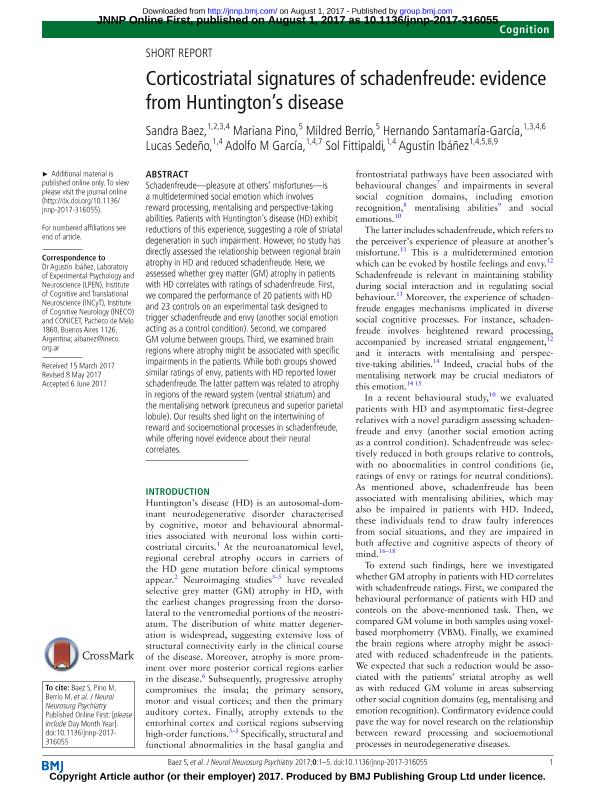Artículo
Corticostriatal signatures of schadenfreude: Evidence from Huntington's disease
Báez Buitrago, Sandra Jimena ; Pino, Mariana; Berrío, Mildred; Santamaria Garcia, Hernando
; Pino, Mariana; Berrío, Mildred; Santamaria Garcia, Hernando ; Sedeño, Lucas
; Sedeño, Lucas ; García, Adolfo Martín
; García, Adolfo Martín ; Fittipaldi, María Sol
; Fittipaldi, María Sol ; Ibañez, Agustin Mariano
; Ibañez, Agustin Mariano
 ; Pino, Mariana; Berrío, Mildred; Santamaria Garcia, Hernando
; Pino, Mariana; Berrío, Mildred; Santamaria Garcia, Hernando ; Sedeño, Lucas
; Sedeño, Lucas ; García, Adolfo Martín
; García, Adolfo Martín ; Fittipaldi, María Sol
; Fittipaldi, María Sol ; Ibañez, Agustin Mariano
; Ibañez, Agustin Mariano
Fecha de publicación:
01/2018
Editorial:
B M J Publishing Group
Revista:
Neuropsychiatry Of Basal Ganglia
ISSN:
0022-3050
Idioma:
Inglés
Tipo de recurso:
Artículo publicado
Clasificación temática:
Resumen
Schadenfreude - pleasure at others' misfortunes - is a multidetermined social emotion which involves reward processing, mentalising and perspective-taking abilities. Patients with Huntington's disease (HD) exhibit reductions of this experience, suggesting a role of striatal degeneration in such impairment. However, no study has directly assessed the relationship between regional brain atrophy in HD and reduced schadenfreude. Here, we assessed whether grey matter (GM) atrophy in patients with HD correlates with ratings of schadenfreude. First, we compared the performance of 20 patients with HD and 23 controls on an experimental task designed to trigger schadenfreude and envy (another social emotion acting as a control condition). Second, we compared GM volume between groups. Third, we examined brain regions where atrophy might be associated with specific impairments in the patients. While both groups showed similar ratings of envy, patients with HD reported lower schadenfreude. The latter pattern was related to atrophy in regions of the reward system (ventral striatum) and the mentalising network (precuneus and superior parietal lobule). Our results shed light on the intertwining of reward and socioemotional processes in schadenfreude, while offering novel evidence about their neural correlates.
Palabras clave:
Envy
,
Gray Matter Atrophy
,
Social Emotions
,
Ventral Striatum
Archivos asociados
Licencia
Identificadores
Colecciones
Articulos(OCA HOUSSAY)
Articulos de OFICINA DE COORDINACION ADMINISTRATIVA HOUSSAY
Articulos de OFICINA DE COORDINACION ADMINISTRATIVA HOUSSAY
Citación
Báez Buitrago, Sandra Jimena; Pino, Mariana; Berrío, Mildred; Santamaria Garcia, Hernando; Sedeño, Lucas; et al.; Corticostriatal signatures of schadenfreude: Evidence from Huntington's disease; B M J Publishing Group; Neuropsychiatry Of Basal Ganglia; 89; 1; 1-2018; 112-116
Compartir
Altmétricas



